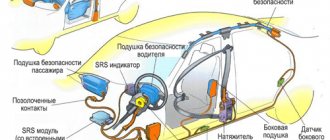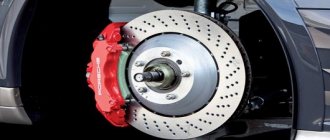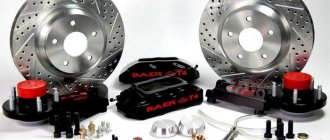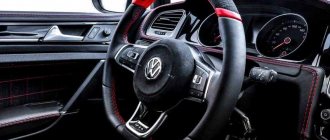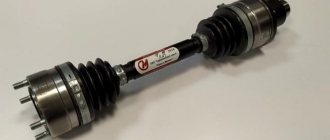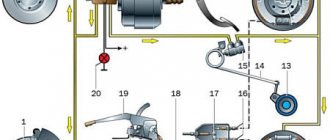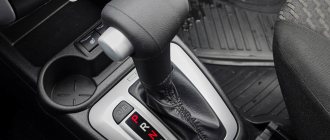The brakes of a modern car have gone through many stages of improvement, both based on new technologies and based on experience in using them in various driving situations. As a result, it turned out that the capabilities of the braking system began to exceed the capabilities of the average driver. Since a person could no longer quickly and effectively use the braking system. An assistant was needed in the form of an electronic system. The abbreviation BAS means exactly that – brake assist.
Description of the emergency braking system
BAS (Break Assist System) is an additional emergency braking system that has been included in vehicles since 2005. According to European Crash Testing Committee for Active and Passive Safety (EuroNCAP) standards, a vehicle cannot receive the maximum crash test score if it does not have BAS.
The auxiliary braking system uses various sensors to collect data on:
- vehicle speed (based on wheel speed);
- the force with which the driver applies the brake;
- limit switch state;
- movement on the VU rod.
All signals are transmitted to the on-board computer. The ECU processes them in a fraction of a second - faster than the driver's reaction - and makes a decision on emergency braking. The system's reaction speed and braking method depend on the type of BAS, but in all cases the assistant's actions are aimed at reducing the braking distance by a couple of tens of percent.
Introduction
The next live broadcast from the Anti-Malware.ru studio took place on April 27, 2021. The topic of cyber attack modeling systems (Breach and Attack Simulation, BAS) was touched upon.
Modern infrastructure cyber protection systems are rapidly evolving, developing and becoming more complex every year. There is not only an increase in the complexity of the systems themselves, but also a constant optimization of security processes in the company.
It is becoming increasingly difficult to determine the vector of movement to strengthen protection. Companies conduct pentests, redtiming, vulnerability scanning - they are looking for various solutions that will help somehow assess the current level of security and see weaknesses. Routine processes require automation of solutions. Data on predicting potential vectors is no longer enough; a systematic launch of simulation of real actions of an attacker is necessary.
BAS solutions help automate this simulation, and the results obtained provide an up-to-date picture of the company’s security status. But what is more effective: pentest, Red Team or BAS? How much does it cost? Which companies are recommended for BAS? Speakers answer questions and discuss the current state of BAS-type systems in Russia and beyond.
The following were invited to the meeting as experts:
- Maxim Pyatakov , Deputy General Director of CTRLHACK.
- Roman Bogomolov , head of technical expertise at Fortis.
- Valeria Suvorova , expert at the Information Security Center.
The moderator was Lev Paley , head of the information security service of SO UES JSC.
Listeners joined the live broadcast: asked questions in the chat, participated in surveys, the results of which formed the current understanding of the topic under discussion. We invite you to familiarize yourself with the key points of the last meeting.
The difference between BAS and EBD, ABS, ESP
EBD is an electronic brake force distribution system. Even though the wheels are on the same car, the tires wear out differently. Because of this, all wheels have different grip on the road. The system analyzes the pressure on the wheel during braking and adjusts the braking force on it. This reduces the likelihood of skidding and allows the driver to maintain control of the vehicle.
ABS - anti-lock braking system. It works so that the wheels do not lock during maneuvers.
ESP - dynamic stabilization system. The most intelligent to date. Prevents skidding by braking one or more wheels.
The main difference between BAS and all of the listed systems is that Break Assist actions are aimed specifically at reducing the braking distance.
Source
Other technologies
Bass systems are installed on a wide variety of car brands today and are mandatory. But time does not stand still and it has been replaced by a more intelligent one, which is triggered not only during emergency braking. It compensates for vehicle slip on slippery surfaces by changing the braking force on different wheels. This is achieved through the use of sophisticated systems with VSC control and switchgear from TRW. It is based, of course, on abs.
BAS - what is this car braking assistance system?
The brakes of a modern car have gone through many stages of improvement, both based on new technologies and based on experience in using them in various driving situations. As a result, it turned out that the capabilities of the braking system began to exceed the capabilities of the average driver. Since a person could no longer quickly and effectively use the braking system. An assistant was needed in the form of an electronic system. The abbreviation BAS means exactly that – brake assist.
conclusions
Cyber attack modeling systems allow you to automatically simulate a real attack (both internal and external) on a company’s infrastructure, help identify weaknesses, and strengthen both the system and security processes. These solutions do not require high qualifications to use them; they have a clear interface and detailed reporting.
BAS is recommended for customers who have a budget and who have mature internal processes. The BAS market is just emerging; there is no fierce competition and the entry barrier for small companies is very high. Vendors offer flexible licensing models.
In Russia, the fashion for such systems is just emerging, and their demand in the market is growing. In the coming years, BAS will become more accessible due to an increase in the number of offers.
Subscribe to our channel, where on May 12, 2022 we will broadcast dedicated to WAF; do not miss! Participate in our polls and discussions, ask questions to speakers and colleagues in the chat, and receive up-to-date information on the latest trends in information security on AM Live.
How the Brake Assist System works
The convulsive actions of a driver in an extreme situation will be easily recognized by the electronics of the BAS system. For this purpose, signals from several sensors are used:
- a limit switch on the brake pedal, which is responsible, in particular, for turning on the brake lamps;
- a pressure sensor in the brake line, which records the force of pressing the pedal and the rate of increase of this force;
- wheel speed sensors that carry information about vehicle speed;
- a displacement sensor on the rod of the vacuum brake booster (VUT), the readings of which can also be used to estimate the speed at which the pedal is pressed.
Of course, the system can be implemented in different ways, and not this entire set of sensors is used on a particular machine.
All data is compiled into an electronic unit, which makes a decision to provide assistance when the maximum emergency braking mode is used. A control signal is generated, which is supplied to control the ABS valve body and the atmospheric valve in the vacuum booster.
As a result, the force from the VUT increases, and additional fluid pressure is supplied to the brake actuator cylinders from the hydraulic pump and the receiver of the ABS module. Braking becomes as effective as possible, as if the driver immediately, sharply and without delay pressed the pedal with maximum force.
Analysis
During the study, it was found that in an emergency situation, when the driver urgently needs to stop the car, he clamps the brake stop quickly enough, but this is not always enough. In this case, the BAS system will come to the rescue. Its functions include constant monitoring of the pressure in the pedal, and the mechanism adjustment panel analyzes the received data without interruption.
If the pressure of the stopper lever exceeds the normal value, the adjustment panel gives a signal to the electromagnetic piston in the stopper vacuum amplifier, which connects one of the parts of the amplifier with atmospheres. As a consequence, the vacuum booster produces the highest voltage and thus the pressure force in the locking mechanism also rises to the highest level.
Types of BAS
Help can be provided both by increasing the fluid pressure at the outlet of the master cylinder module with a brake booster, and inside the ABS valve body.
Pneumatic system
The vacuum brake booster, which is found in almost every car, operates on the pneumatic principle. It consists of two chambers separated by a flexible membrane, in one of which a vacuum is created from the engine intake manifold or a separate vacuum pump, and the other can be controlled controlled by air under atmospheric pressure.
The boost, that is, the additional force applied to the rod of the master cylinder, depends precisely on the difference between these two pressures.
During normal braking, the booster operates normally, relieving some of the stress from the driver's foot on the pedal. But if the rod moves too quickly and with significant force, an additional valve system is activated, immediately applying the entire force of atmospheric pressure to the membrane.
It turns out that with the same force of the driver’s foot, a significantly greater force is already applied to the piston of the main cylinder. VUT operates according to emergency rules.
Hydraulic system
On machines equipped with ABS, there is already a hydraulic unit that combines a system of valves that allows or shuts off fluid pressure to the actuating wheel mechanisms, a hydraulic pump with a receiver that creates and accumulates significant energy from the fluid under pressure, and control electronics. ABS sensors are also used to create the BAS hydraulic drive.
With such tools, it is quite enough to recognize the situation of an extreme case and force the valve body to work according to the driver assistance algorithm if it cannot cope on its own. That is, apply pressure from the pump to the wheel brakes to the maximum extent, while simultaneously allowing ABS and other systems to operate as normal to maintain stability and controllability.
This is what the electronic unit does, analyzing the driver’s behavior, sometimes even in such trifles as the speed of moving the foot from the accelerator pedal to the brake pedal.
The difference between BAS and EBD, ABS, ESP
The main difference between the BAS system and all others, based on an already standard set of sensors, hydraulics and electronics, is that only it is uncompromisingly and directly focused on reducing the vehicle’s braking distance in the event of an emergency.
All other systems, to varying degrees, pay more attention to maintaining stable behavior of the car, preserving its ability to respond to steering, and countering all kinds of drifts, skids and slides.
Of course, the same ABS, which has become the basis for all electronic assistants, is also capable of reducing braking distance in many situations; even more likely, the opposite will be an exception that must be eliminated in new versions of the system.
But it can relieve pressure from the brake pistons for some other purpose not related to shortening the stopping distance, but BAS does not. Quick deceleration assistance can only be switched off when you take your foot off the pedal, leaving other systems responsible for stability.
Source
BAS – Brake Assist System
There are different types of emergencies. In some cases, the driver may simply become confused, and then his reaction to a critical situation will be inadequate or completely absent. But very often the sad consequences of an accident occur only because the driver did not brake hard enough, using the power of the braking system by 70-80%. Of course, the force of pressing the brake pedal depends on several factors, but in any case, this missing 20-30% is a very significant value that would save a huge number of lives. And automakers could not ignore such an important factor. As a result, the first devices appeared to assist drivers during forced emergency braking, providing the opportunity to reduce braking distances by approximately 25-40%.
Purpose and principles of ABS
The ABS (anti-lock braking system) system prevents all wheels from locking at once. At the same time, the car continues to have maneuverability, stability while driving, and in case of poor adhesion to the surface (in the presence of snow, ice, gravel, wet asphalt, leaves clogging the treads), the braking distance is noticeably reduced. It is worth considering the fact that the car remains under the control of the driver, even when the brake pedal is fully pressed to the floor.
The anti-lock braking system is not a panacea for all problems and situations that arise when braking and minimizing braking distances on the road. This is only a separate mechanism, the principle of operation of which determines and is responsible for blocking the wheels and helps to hold the vehicle at a controlled moment of braking.
Dangerous situation
Locking the wheels prevents the car from skidding, as well as from inadvertently moving to the side.
But surprises can arise when there is a difference in axle loads when braking, or, more uniquely, different tires are installed, and the specific road surface can also influence. It is also worth considering that when the wheels are locked, the trajectory of movement is influenced by lateral force factors. Any slope of the roadway or side impact can unbalance the situation, and it is unrealistic to predict the movement in this case.
Key facts and features
In some examples, driving a vehicle on dry asphalt and using the ABS system can only increase the braking distance. In a number of circumstances, this is due to the calibration and sensitivity of the ABS, especially when driving on highways, and the operation of the system at high speeds.
The second important point is the kickback and vibration of the brake pedal when the ABS system is activated. For beginners and most inexperienced drivers, this will cause an extraordinary perception. To overcome such embarrassments and not to get confused while driving, it is necessary to undergo practice at the designated training areas.
Operating principle and development of ABS
The principle of operation of ABS is initially simple - it counteracts wheel locking during braking. In fact, the system tries to reproduce the actions of experienced drivers who, with their skills and actions with the brake and steering pedals, prevent wheel locking due to intermittent braking. In emergency moments, a person can instinctively press the brake pedal as hard as he can - in this case, the electronics, based on data from the sensors, will coordinate the excess pressure and force the brake pads to release, and repeat this cycle each time again, until the full braking point. ABS performs the braking process with a special frequency of checks and is based on programmable operating principles of electronic mechanisms. The consequence of this is not only the minimum braking distance, but also the pliable behavior of the steering wheel, because the wheels absorb all the braking force, allowing you to use the steering mechanism.
Nowadays, the ABS system has been widely developed. It is installed on both cars and trucks, motorcycles and trailers. The system has been upgraded to an electronic form, endowed with a huge number of sensors and systems, endowed with additional standards and innovations. Added anti-slip functions, electronic control and road stability behavior, as well as the BAS emergency braking system.
What is BAS
Brake assistant - the most succinct name for these devices - literally translates as “braking assistant”. But at the instigation of the Mercedes-Benz automaker, which first used such a system in a production car in 2005, they were given a more capacious name - Brake assist system, or BAS for short. But this, so to speak, is a generalized name for the group - each automaker names its system differently.
Within devices of this type, two subgroups are distinguished:
- systems for providing assistance to the driver when forced to sharply press the brake as a result of an emergency;
- automatic assistants that perform emergency braking of the vehicle in automatic mode, without driver participation.
The task of the former is to increase the sharp pressure on the brake (which, as already mentioned, is rarely complete) to the maximum possible. The latter perform almost the same work, but completely autonomously, without relying on the driver’s reaction. Let's look at what a BAS assistant is in a car by selecting the first type of device.
Systems that enhance braking force do so through the use of a pneumatic or hydraulic mechanism.
Pneumatic system BAS
Its main elements are located in the vacuum amplifier. The actual task of pneumatic devices is reduced to increasing the efficiency of the air conditioner. Composition of a typical pneumatic system:
- sensor for measuring the speed of movement of the rod VU, located inside the amplifier;
- actuator – electromagnetic rod drive;
- on-board computer.
As a rule, the pneumatic assist works in conjunction with ABS.
The principle of operation is that the assistant recognizes the nature of the vehicle braking. An emergency is determined when the speed of movement of the CU rod exceeds a certain threshold value. This value is measured by the sensor and transmitted to the ECU, which makes the decision to activate BAS.
This happens by turning on an electromagnetic drive that pushes the rod all the way, and the system’s response speed is higher than that of ABS, which allows for increased braking to maximum, at which, as already noted, the braking distance is reduced by at least a quarter.
Hydraulic system
The functioning of the auxiliary braking system of the hydraulic assistant BAS is based on the interaction of the assistant with the standard exchange rate control device: the increase in the force applied to the pedal by the driver behind the wheel to the maximum level occurs due to an increase in the pressure level of the hydraulic fluid in the ESC system units.
Composition of the hydraulic assistant:
- pressure sensor installed in the shopping center;
- a vacuum sensor installed in the control unit (or a sensor that measures wheel speed);
- brake light switch relay.
Analyzing the information received from the sensors, the on-board computer, if it is necessary to initiate emergency braking, activates the hydraulic pump of the ESC system, generating the maximum pressure in the TC in real time, which is maintained until the vehicle stops.
Features of the functioning of the automatic BAS system
In contrast to assistants that maximize braking force, the automatic BAS system for providing the driver with emergency braking assistance is a more advanced device that reacts not so much to the pedal being pressed, which may be late, but rather takes into account the road situation using radars and high-speed video cameras. If the distance between the car and any other obstacle located in front of the cameras decreases, the car begins braking in order to increase the distance to a safe one. When the distance decreases critically, braking will be maximum possible, regardless of whether the driver reacted to the situation.
The automatic assistant, in addition to the emergency braking function, can perform other work. For example, warn the driver in advance about unacceptable proximity to the vehicle ahead, and also activate passive safety features. It is no coincidence that systems of such a shooting range are sometimes called preventive.
The operation of the automatic BAS system is based on the use of elements of other systems:
- ACC (control of a safe distance to an object, or adaptive cruise control);
- ESC (automatic braking device, part of the exchange rate control system).
In terms of design implementation, an autonomous auxiliary braking system, designed according to the BAS type, can have both a hydraulic and a pneumatic drive. The only difference is the use of more information sent to the ECU, including factors such as distance to obstacles in front. In this case, the on-board computer does most of the work, since it must adjust the braking force in real time depending on the road situation.
In general, an increasing number of automakers are equipping their cars with such active safety features that allow novice drivers who have no experience of correct behavior in critical situations to effectively brake, as well as physically weak people (primarily women), who, if necessary, simply cannot depress the brake pedal.
Note that the BAS system for activating braking assistance, regardless of type, works most effectively in conjunction with other devices:
- EBD, the purpose of which is to distribute the braking force directed to individual wheels depending on the road situation;
- ABS, which prevents skidding when the wheels are locked.
Using emergency braking devices
Historically, the first active safety system to be introduced was ABS, which appeared in the late 70s of the last century and was initially installed exclusively on elite models. Assistants like BAS began to be introduced much later, when anti-lock braking systems had already become standard for the middle class of cars. But over time, the reduction in cost of electronic components and the start of mass production have led to the fact that devices that provide emergency braking are no longer uncommon today.
This was also facilitated by the fact that, starting from 2014, it is impossible to obtain the maximum rating in crash testing conducted under the auspices of EuroNCAP if the car is not equipped with a BAS-type emergency braking system, which forced many automakers to introduce it on most models, with the exception of the most budget level.
However, just increasing pressure on the brake is no longer enough, because drivers often find themselves in situations where they simply do not have time, or do not have the opportunity to react to an unexpected obstacle.
Such assistants are quite complex complexes, equipped, in addition to standard sensors, with devices that make it possible to determine the distance to objects in the direction of travel of the vehicle (radars, laser rangefinders, high-speed video cameras).
For their normal operation, increased demands are placed on the on-board computer, because the load on it increases every year, as does the number of different sensors, information from which it must process virtually simultaneously.
Many automakers give such devices original names. In particular, the following pneumatic type BAS systems currently exist:
- EBA (short for Emergency Brake Assist) - this name is used on cars of the brands BMW, Volvo, Mercedes-Benz, Toyota;
- AFU (short for Aide Freinage d'Urgence) - installed on passenger cars of French origin.
Hydraulic-type BAS systems also have several implementations with different names:
- HBA (short for Hydraulic Braking Assistance) is an abbreviation used by Audi and Volkswagen for their cars;
- HBB (short for Hydraulic Brake Booster) is another type of hydraulic braking assistants from the Audi/Volkswagen brands;
- SBC (short for Sensotronic Brake Control) is used by Mercedes;
- BA Plus (an abbreviation derived from Brake Assist Plus) is another prerogative of the Mercedes brand;
- DBC (short for Dynamic Brake Control) is a BAS used by the BMW automaker.
Although in general the principle of operation of such assistants is the same, their implementation may differ. In particular, the SBC system takes into account not only the speed at which the foot is pressed on the brake pedal, but also the force applied by the driver, as well as the road condition and the vehicle's movement vector. The ECU analyzes this information, generating the most effective braking force at a particular moment in time, and it can be different for different wheels.
The BAS emergency brake booster in the BA Plus version can also determine the distance to an object located in front, warning the driver about the appearance of danger and, if necessary, applying additional braking to the car.
Of course, not all models are equipped with such devices - mostly only the top-end configurations. We can only hope that soon braking assistants will become as commonplace as airbags and ABS systems.
Automatic BAS are considered even more complex and expensive. Today you can find the following modifications:
- PSB (short for Pre-Safe Brake), developed by the Mercedex-Benz automaker;
- CMBS (short for Collision Mitigation BrakingSystem), installed on Honda cars;
- CBC (short for City Brake Control), developed by Fiat engineers;
- ACS and FA (Activ City Stop and ForwardAlert systems) can be found on Ford products;
- FCM (short for Forward Collision Mitigation) is installed on cars under the Mitsubishi brand;
- CEB (short for City Emergency Brake) – developed by design engineers from Volkswagen;
- CWAB and CS (Collision Warning AutoBrake, City Safety) - automatic BAS from Volvo;
- PEBS (short for Predictive Emergency Braking System) is one of the few devices developed by a non-automaker - the German company Bosch;
- AEB (short for Automatic Emergency Braking) is an assistant from TRW.
In many of the presented BAS systems for the car, in addition to the function of automatically turning on emergency braking, there are other capabilities, including warning the driver about a situation that threatens a collision with another object, as well as activating passive safety systems.
When you just need help...
In principle, the meaning of the existence of the emergency braking system is clear from its name, but there are nuances that are worth knowing about.
So, the BAS (Brake Assist System) technology we mentioned at the very beginning of the article is actually more correctly called an emergency braking assistance system, and this caveat is very important!
The principle of its operation is as follows - the electronics calculates the moment when you sharply hit the brake pedal (which means something wrong has happened), and, as it were, presses it to the maximum, increasing the pressure in the line to the highest possible value.
Thanks to this, the car will stop quickly and without human hesitation. BAS technology is just one of many variations of such a system, used on the creations of Mercedes-Benz, BMW, Toyota, and other automakers.
Each automaker comes up with names for its system to highlight its interests - AFU, EBA, HBA, SBC and so on, so the names are different, but the principle is the same.
Technically, there are two options for the emergency braking assistance system:
- pneumatic;
- hydraulic.
The first type, when detecting a sharp press on the brake pedal, which is connected to the vacuum booster and its rod, activates a special electromagnet that brings the position of the rod to its extreme position.
Thanks to this, the pressure in the brake line becomes maximum. This scheme works in conjunction with ABS, which, in turn, prevents the wheels from locking.
Mercedes-Benz, Toyota, BMW, Volvo use BA, BAS, EBA systems, while Renault, Citroen, Peugeot use AFU.
Hydraulic versions of Brake Assist also monitor the force with which the driver presses the pedal, but other sensors are sometimes present to help the electronics analyze the situation more deeply. The maximum braking force in this type is achieved by pumping the pressure of the working fluid into the line with pumps.
Emergency hydraulic braking assistance systems include:
- Hydraulic Braking Assistance (HBA) - Audi and Volkswagen;
- Dynamic Brake Control (DBC) - BMW;
- Hydraulic Brake Booster (HBB) - Audi and Volkswagen;
- Brake Assist Plus (BA Plus) - Mercedes-Benz;
- Sensotronic Brake Control (SBC) - Mercedes-Benz/
//www.youtube.com/watch?v=mfKQAwrAzsc
BAS Service
The status of Brake assist type assistants is, in principle, included in the basic diagnostics of any computer that supports the operation of such systems. On Mercedes cars, if the phrase “BrakeAssist visit workshop” appears on the display, you should contact a car service center, which is what this inscription indicates, indicating that a malfunction has occurred. The operation of the braking system in this case is not impaired, we are only talking about emergency braking.
Sometimes after turning off/on the power unit the warning disappears, but in most cases it appears again over time.
It is quite difficult to independently identify the cause of a failure, especially if there is an automated BAS. The fact is that a considerable number of sensors are involved here, some of which are difficult or even impossible to check without modern diagnostic equipment.
The most accurate way to determine the cause of failure of the emergency braking device is by analyzing the error codes generated by the auto scanner. Please note that such a device may be incompatible with the software used in a particular car model.
Source
